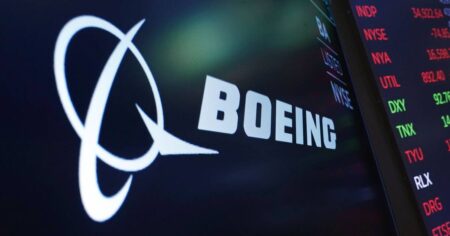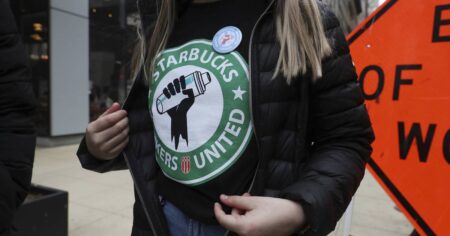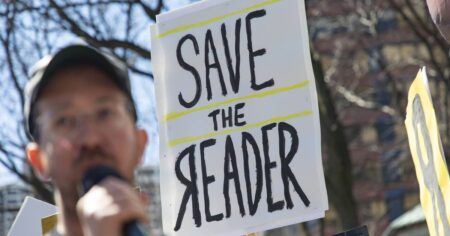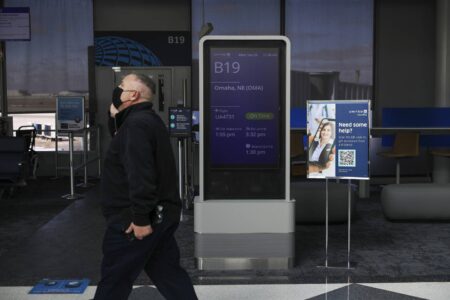Subscribe to Updates
Get the latest creative news from FooBar about art, design and business.
Browsing: Business
Meta, the social media giant formerly known as Facebook, is expanding its massive $1 billion data center under construction in DeKalb to nearly 2.4 million square feet, putting the college town west of Chicago at the center of its metaverse.Slated to open next year, the five-building complex filled with servers and other computing equipment, will create 200 jobs and power everything from Facebook posts to Instagram photos as one of 17 Meta data centers across the U.S.Advertisement“This is the physical backbone of all of our apps and services,” said Meta spokesman Tom Parnell.The expansion, announced Thursday, will make the DeKalb data center one of Meta’s largest facilities, and an integral part of its ambitious plans to expand its social media platforms into an immersive virtual reality experience, Parnell said.AdvertisementMeta’s bricks-and-mortar data centers supply the massive computing power needed to share information and connect users on the evolving social media platforms. The company has 14 data centers operating in the U.S., with three under construction, including DeKalb.The DeKalb data center broke ground in 2020, starting with two buildings that are now 70% complete, Parnell said. Construction on the three additional buildings began in January, and the infrastructure buildout at the sprawling 505-acre site is expected to be finished in 2023.Meta is hiring 200 workers to operate the facility, with positions ranging from technicians and electrical engineers to culinary staff. About half of the employees are already onboard, preparing the data center for its launch next year.“The impact Meta has made within the City of DeKalb goes beyond just an economic one,” DeKalb Mayor Cohen Barnes said in a news release. “Since day one, they have made a concerted effort to make a larger impact on DeKalb, and I look forward, with this announcement, to seeing that partnership continue to grow over the years to come.”The demand for data centers has been growing exponentially in recent years, spurred by the heightened need for cloud technology and remote connectivity during the COVID-19 pandemic, which saw work-from-home go mainstream. The adoption of long-term hybrid strategies for many companies portends continued growth, according to industry analysts.The Chicago area is tied with Atlanta as the fourth largest data center market in the world behind Northern Virginia, Silicon Valley and Singapore, according to a new study by Cushman & Wakefield. The study cites low cost of land, a robust development pipeline and lower power costs than most large data centers as advantages for Chicago.The study also notes that Chicago-area sites come with “sizable incentives,” a factor that helped bring Facebook/Meta to DeKalb.In 2019, Illinois created the Data Center Investment Program, offering an exemption from state and local sales and use taxes for companies that invest at least $250 million and create 20 new operational jobs in a data center. The program also requires the data center to be carbon-neutral.AdvertisementFacebook was granted the data center sales tax exemptions by the state, Parnell said.As part of the green building requirement, Meta is partnering with the University of Illinois at Urbana-Champaign to develop a more sustainable concrete mix for construction of the data center. Meta has also invested in two new wind energy projects in Morgan and DeWitt counties, with the goal of supporting DeKalb data center with 100% renewable energy.One thing the DeKalb data center ostensibly won’t be processing is facial recognition technology after agreeing to pay $650 million in a landmark settlement over alleged violations of Illinois’ biometric privacy law.In November, Facebook announced it would shut down its facial recognition system amid “growing concerns” over the widespread use of the technology. As a result, Facebook said it planned to delete more than a billion facial recognition templates it had stored, putting an end to the feature that automatically recognized if people’s faces appear in memories, photos or videos.About 1.6 million Illinois Facebook users who filed claims can expect to receive their $397 checks beginning May 9, according to Chicago attorney Jay Edelson, who brought the lawsuit against Facebook seven years ago.rchannick@chicagotribune.com
Former Chicago Blackhawks defenseman Steve Smith, who played for the team for six seasons in the 1990s, on Tuesday sold a four-bedroom, 4,822-square-foot house in Oak Brook for $1.26 million.Since retiring from his playing career, Smith, who now is an assistant coach for the New York Rangers’ Hartford Wolf Pack developmental hockey team, also has had a career as a homebuilder. In 2018, he paid $780,000 for the house in Oak Brook’s Brook Forest subdivision, and he subsequently set about on a dramatic overhaul of the home.AdvertisementSmith’s work included significantly expanding the second floor and raising the ceiling of the front entrance hall to produce a more light-filled entry. To execute the renovation, Smith used Hinsdale-based G.O. Architectural Design for the design work.The house has 2 ½ bathrooms, a family room with a fireplace, a glass-enclosed all-seasons room and a lower-level exercise room, all on a 0.48-acre property.AdvertisementSmith listed the house in December for $1.29 million.In a phone interview, Smith declined to comment on the sale.The house had a $9,492 property tax bill in the 2020 tax year.Bob Goldsborough is a freelance writer.Join our Chicago Dream Homes Facebook group for more luxury listings and real estate news.
Boeing said Wednesday that it lost $1.2 billion in the first quarter as it and took large write-downs and lost money in both its civilian-airplane and defense businesses.The loss was bigger than Wall Street had forecast, and the company’s quarterly revenue also fell short of expectations. Boeing burned through $3.2 billion in cash.Advertisement“Messier quarter than any of us would have liked,” CEO David Calhoun acknowledged on CNBC.Shares of Boeing Co., based in Chicago, fell 10% shortly after the opening bell Wednesday.AdvertisementBoeing offered some optimism for improvement, however, saying that it has submitted plans to resume deliveries of its 787 airliner and it increased production and deliveries of the 737 Max passenger jet during the quarter.Calhoun said the company was on track to generate positive cash flow over the entire year “despite the pressures on our defense and commercial development programs.”The quarterly report brought disappointing news for Boeing shareholders on several fronts.The company again pushed back the expected first delivery of a new version of its long-range, twin-aisle 777 passenger jet by at least a year until 2025. The move was widely expected, as Boeing adapts to certification standards that have been tightened since regulators approved the Max, then were forced to ground the planes after two deadly crashes.The delay in expected approval for the 777-9 caused Boeing to forecast $1.5 billion in “abnormal” production costs.Boeing took a $660 million charge for its program to build new presidential Air Force One jets, which it blamed on higher supplier costs, final technical requirements and schedule delays. It also took $367 million in charges on a military training jet.Boeing said it submitted plans to the Federal Aviation Administration to resume deliveries of the 787 passenger jet. Those deliveries have been halted for more than a year by production issues that Boeing previously said would add about $2 billion in costs, of which $312 million was recorded in the first quarter.Airlines are expecting a boom summer, with travelers returning in huge numbers after two years of pandemic. But some of them, like American, have trimmed summer schedules because they haven’t received the Boeing 787s that they ordered years ago.Advertisement“They have a busy summer schedule. We have already disappointed them with respect to the capacity on that summer schedule,” Calhoun said. Just when Boeing will be cleared to resume deliveries of 787s is up to the FAA, but Calhoun said “We will be back in the air sooner rather than later.”Boeing expects to boost production of the 737 Max to 31 planes a month in the current quarter, which runs through June. That plane was grounded worldwide for nearly two years after two deadly crashes.And Boeing took $212 million in pretax charges related to Russia’s invasion of Ukraine. The company did not immediately explain the write-down.In a memo to employees, Calhoun said Boeing is taking steps to improve long-term performance.“We are a long-cycle business, and the success of our efforts will be measured over years and decades, not quarters,” he said.Boeing’s commercial-airplanes division lost $859 billion, hobbled by the inability to deliver 787 jets while Boeing tries to fix production flaws on the twin-aisle plane.AdvertisementThe defense business, long a bulwark against volatility in aircraft sales to airlines, lost $929 million as revenue fell 24%.The company reported a loss attributable to shareholders of $1.22 billion, compared with a loss of $537 million a year earlier. The “core” loss was $2.75 a share on revenue of $13.99 billion. Analysts expected a loss of 25 cents per share on revenue of $16.02 billion, according to a FactSet survey.
Illinois residents who have appeared in a photograph on the Google Photos app within the last seven years may be eligible for a cut of a $100 million class-action privacy settlement reached by Google this month.The lawsuit alleges Google’s face grouping tool, which sorts faces in the Google Photos app by similarity, runs afoul of Illinois’ biometric privacy law. The law requires companies to get user consent for the use of such technologies. AdvertisementThe settlement was filed in Cook County Circuit Court April 14, and Judge Anna M. Loftus issued an order granting preliminary approval of the agreement Monday.The lawsuit was first filed in the U.S. District Court for the Northern District of Illinois in March 2016. The plaintiffs filed suit in state court in 2019 after a judge found they lacked standing to pursue their claims in federal court.AdvertisementIf a final order is approved in the case, Illinois residents who appeared in a photograph in Google Photos between May 1, 2015, and the date of the settlement’s preliminary approval would be eligible to take part in the deal. While the amount of the payments will depend on how many people file claims, attorneys estimate each class member will receive between $200 and $400, according to the agreement.“We’re pleased to resolve this matter relating to specific laws in Illinois, and we remain committed to building easy-to-use controls for our users,” Google spokesperson José Castañeda said in a statement Tuesday.Castañeda said Google Photos users in Illinois would be prompted to provide opt-in consent to face grouping in the coming weeks. Those changes will also be gradually rolled out across the U.S., he said. Users can choose to turn face grouping off, in which case face groups will be deleted from their accounts.Each of the five named plaintiffs in the case is eligible to recieve a $5,000 payment, and attorneys will be able to apply for up to $40 million in fees plus costs and expenses, to be paid out of the settlement fund, according to the agreement.Attorneys for the plaintiffs were not immediately available for comment Tuesday evening.The Illinois Biometric Information Privacy Act, passed in 2008, is among the strictest such laws in the U.S. Last year, Facebook received approval for a landmark $650 million class-action settlement in an Illinois biometric privacy case over its facial tagging feature, but the payouts were delayed more than a year after two objectors appealed the award of attorneys’ fees in the case. In March, the U.S. Court of Appeals for the 9th Circuit upheld the February 2021 class-action settlement and attorney fee award, freeing up payments for the 1.6 million Illinois Facebook users who filed claims. Those who did should expect to see checks of almost $400 in the mail starting next month. AdvertisementA final approval hearing for the Google settlement is scheduled for September.
U.S. regulators are calling on Amazon to improve its procedures for dealing with severe weather like hurricanes and tornadoes that could threaten workers at its warehouses dotted across the country.The Occupational Safety and Health Administration on Tuesday sent a “Hazard Alert Letter” to the Seattle-based e-commerce giant on Tuesday following the agency’s investigation into the deadly collapse of a company warehouse in Edwardsville, Illinois in December. Six people died and another was critically injured in the tornado strike.AdvertisementThe investigation raised concerns about the potential risk to employees during severe weather emergencies, according to the letter sent to Amazon that OSHA made public.The agency said its inspection found that, while the company’s severe weather procedures had met minimal federal safety guidelines for storm sheltering, the company still needed to further protect its workers and contract employees. The letter requires Amazon to review its severe weather emergency procedures but the company won’t face any fines or penalties.AdvertisementIn interviews with Amazon and contract workers, OSHA officials found some employees couldn’t recall ever participating in severe weather drills, or the location of the facility’s shelter. Kelly Nantel, an Amazon spokesperson, however, said employees receive emergency response training, which is “reinforced throughout the year.”“OSHA’s investigation did not find any violations or causes for citations, but we’re constantly looking to innovate and improve our safety measures and have already begun conducting additional safety and emergency preparedness drills at our sites and will carefully consider any OSHA recommendation that we have not already,” Nantel said.Amazon has noted workers at the warehouse, known as a “delivery station,” had little time to prepare when the National Weather Service declared a tornado warning on December 10. About 10 minutes before the tornado touched down, the agency said managers directed workers to go to a restroom in response to tornado warnings and other weather alerts.But some employees unaware of the designated tornado shelter — a restroom located in the northern portion of the building — went to a separate restroom in the hard-hit south end, the agency said. All the injured and killed had taken shelter in the south side bathroom.John Felton, Amazon’s senior vice president of global delivery services, had said in December that most of the 46 people in the warehouse headed to a shelter on the north side while a smaller group went to the south end, where the loading docks were located and delivery vehicles were parked.“The tornado that hit our delivery station was extreme and very sudden, with winds that were much like the force of a category 4 hurricane, and we believe our team did the right thing, moving people to shelter as soon as the warning was issued,” Nantel said.In the inspection, the agency said it also reviewed contractor safety and training records as well as the facility’s written “Emergency Action Plan.” Officials took issue with the plan, writing in the letter it “was not customized with specific instructions” for hazards expected at the Edwardsville site.Though Amazon had posted evacuation maps at the facility showing the location of the designated shelter, officials found the written plan did not “specifically identify” the shelter’s location in the warehouse. Nantel said the company’s buildings have “emergency plans that identify exit routes and shelter areas.”AdvertisementSeparately, officials said a megaphone that was supposed to activate the site’s shelter-in-place procedure was locked in a cage and not accessible, resulting in managers verbally telling workers on where to take shelter.“These tragic deaths have sparked discussions nationwide on the vital need for comprehensive workplace emergency plans,” William Donovan, OSHA’s regional administrator in Chicago, said in a statement. “Employers should re-evaluate their emergency plans for the safest shelter-in-place locations and prepare before an emergency to ensure workers know where to go and how to keep themselves safe in the event of a disaster.”The agency has recommended Amazon makes its warning devices readily accessible, ensures all employees participate in drills for emergency weather events and include site-specific information in its emergency plans. It said it will also send hazard alert letters to three delivery service providers, who employed the injured worker and five of the employees who died.
Workers at Starbucks locations in Cary and Peoria won union elections Tuesday, making the stores the first and second Starbucks to unionize in Illinois.Starbucks employees in Cary voted 17-4 and employees in Peoria voted 9-2 to unionize, said Esau Chavez, a union organizer with the Chicago and Midwest Regional Joint Board of Workers United. Workers United is the Service Employees International Union affiliate that represents the Starbucks workers.Advertisement“We’re feeling incredibly empowered,” said Jon Gill, a barista at the Peoria store at 1200 W. Main St. in the Campustown Shopping Center.“The wins that we are seeing at Starbucks are proof that no massive corporation is invincible,” said Gill, who has worked at the Peoria location since December. Gill said they would like to see wage increases as well as a contract with guaranteed hours so employees’ access to the company’s benefits is protected.Advertisement“Workers do have power, and if they organize, they can reach that power,” Gill said.Employees at 230 Starbucks locations have filed for union elections in 31 states, according to Casey Moore, a barista on the Starbucks Workers United communications committee. Out of 35 stores that have had elections, 32 have voted to unionize, Moore said.In statements, organizing committees at both Illinois stores celebrated Tuesday’s votes.“This is a win for every store, and really every partner that works for Starbucks. There is still a long road ahead, but we look forward to working with corporate as partners in making Starbucks the best employer for essential workers,” said workers at the Cary store, which is located at 620 Northwest Highway.“Our victory here in Peoria is a product of the incredible organizing that Starbucks workers have done across the country. We stand in solidarity with every Starbucks worker and any worker fighting for a better world,” the Peoria organizing committee said.A representative for Starbucks did not immediately respond to a request for comment.Parties have one week to file objections to the votes with the National Labor Relations Board, said agency spokesperson Kayla Blado. If no objections are filed, the results will be certified.In Chicago, six stores have filed for elections, according to Grace Easterby, an organizer with the Chicago and Midwest Regional Joint Board of Workers United. Three of those stores — in the Loop, Logan Square and Hyde Park — have election dates set for June 7, with ballots going out to workers in early May.AdvertisementThe other Chicago Starbucks that have filed for union elections are in Bucktown, Edgewater and Edgewater Beach. tasoglin@chicagotribune.com
Chicago Reader co-owner Len Goodman and three board members stepped down Tuesday amid protests from employees, freeing the embattled alternative newspaper to transition to a nonprofit organization.The Reader has been stuck in limbo since December, when a planned transition to a nonprofit model was delayed over concerns about alleged censorship of an opinion piece written by Goodman, who pushed for an investigation into the matter and more representation on the successor board.AdvertisementGoodman announced Tuesday he was stepping away from the Reader immediately over “an unresolvable impasse” with fellow co-owner, Chicago real estate developer Elzie Higginbottom, who wanted to move forward with the planned transition to a nonprofit newspaper.“We cannot continue the fight without destroying the Reader,” Goodman said in a statement. “I am stepping aside. I will sign off on the sale so that the Reader can transition immediately to NFP status.”AdvertisementBoard members Dorothy Leavell, Sladjana Vuckovic and Carol Bell, who were aligned with Goodman’s concerns, announced they were also stepping down immediatelyFrustrated Reader editorial employees organized a rally last week in front of Goodman’s Lakeview East home and planned another one for Thursday morning in an effort to get the Chicago criminal defense attorney to relinquish control and let the newspaper move forward as a nonprofit. Goodman blamed Reader management for not addressing his concerns.In 2018, Goodman and Higginbottom bought the Reader from the Chicago Sun-Times for $1 and the assumption of debt. Since then, they have invested more than $1 million each to keep it afloat, weathering the pandemic and supporting the money-losing publication as it planned to transition to a more sustainable nonprofit model.That plan was delayed after editors pushed back on a November opinion piece by Goodman expressing concerns about vaccinating his 6-year-old daughter against COVID-19, which created backlash on social media for some disputed scientific claims.More to come.rchannick@chicagotribune.com
United Airlines is adding new flights between Chicago and two European cities, as the carrier eyes the return of international travel.AdvertisementThe two Chicago routes are part of a major trans-Atlantic expansion by United, which plans this spring to begin new or expanded service to multiple international cities and vacation destinations. That includes new service to Amman, Jordan; Bergen, Norway; the Azores and the Canary Islands, among others. Destinations that will get expanded service include Dublin and Frankfurt.In Chicago, daily flights began this week to Zurich. The route was initially set to begin in March 2020, but was put on hold because of the pandemic.AdvertisementThe Boeing 767-300 aircraft that are flying the 9-hour route have extra space devoted to business class seats. The flight is intended to cater to both business travelers trying to reach the European financial center and leisure travelers, United executives said in a news release.On May 6, United will also begin daily flights between Chicago and Milan. The airline currently flies between Milan and New York.The new flights, announced in October, come as United anticipates the further return of international travel as pandemic restrictions ease. Along with business flights, international travel was especially hard hit during the pandemic.A person walks past United Airlines signage at O’Hare International Airport in Chicago on Feb. 23, 2022. (Jose M. Osorio / Chicago Tribune)United Airlines said last week it was “seeing indications that business travel is rapidly returning” and expects more upticks in international travel.“This is really kind of the coming-out party for the real return of business travel and international travel in this quarter,” CEO Scott Kirby told analysts during an earnings call. “We are in the first inning of that recovery.”The comments came as the carrier reported it expected to return to profitability in the current quarter, after a first quarter loss of $1.38 billion. United is still running fewer flights than pre-pandemic, but said it has reopened lounges, resumed more than a dozen international routes and restarted service to six cities that hadn’t been served since before the pandemic. United executives also said they were pleased mask requirements had ended for airports, domestic flights and some international flights, depending on the arrival country’s mask rules. They called for an end to preflight COVID-19 test requirements, and said the elimination of those rules could make travel easier.“While travel demand is surging, we believe eliminating these requirements will ease the travel experience for our customers,” United President Brett Hart said.AdvertisementInternational business travel was increasing, and the airline expected good trans-Atlantic business travel levels compared with 2019, Chief Commercial Officer Andrew Nocella said. It hasn’t seen meaningful recovery in business travel to Asia.While many of the new and expanded routes set to begin in the coming weeks are geared toward vacationers, some of the routes are targeted specifically toward business travelers, said Patrick Quayle, United’s vice president of international network. That includes the new Chicago-Zurich flight, and a route between Denver and Munich, he said.“We are seeing strong demand and strong pickup for those flights,” he said.The Associated Press contributedsfreishtat@chicagotribune.com
Aldermen are pushing back against the three proposed finalists for a Chicago casino, as the city nears a final selection amid growing concern from residents about locating a casino in their backyards.The Special Committee on the Chicago Casino, which was created last month to help winnow the casino proposals from three to one, fielded questions at a virtual meeting Monday about everything from timing and process to whether two discarded proposals involving McCormick Place could be resurrected.AdvertisementThe city, which is banking on a casino to generate $200 million in annual tax revenue to plug its public pension funding holes, plans to submit its choice to the Illinois Gaming Board for approval in time to include upfront payments from the winning bidder in the 2023 fiscal budget this fall, said Ald. Tom Tunney, 44th, chairman of the committee.“We would like to be able to, hopefully, within the next month, get narrowed down to one and then obviously go through this process with the nominee,” Tunney said.AdvertisementIn March, Chicago Mayor Lori Lightfoot narrowed the city’s five proposals to three finalists: Bally’s at the Chicago Tribune Publishing Center in River West, Rivers at The 78 in the South Loop and Hard Rock at the proposed One Central development on the Near South Side.Reaction from residents at community engagement meetings held earlier this month was overwhelmingly negative, and aldermen representing nearby neighborhoods echoed concerns Monday about crime, traffic, safety, noise and the use of the Chicago River in two of the three proposals.Ald. Brendan Reilly, 42nd, objects to the Bally’s Tribune proposal adjacent to his ward, which includes River North. He cited an April survey by the River North Residents Association that found 86% of nearly 2,000 respondents were opposed to the casino.“Perhaps if the city had engaged with the aldermen on potential sites and helped gear that conversation and guide it with the potential developers and operators, that might have produced less acrimony and more upfront consensus on how best to locate this casino,” Reilly said during Monday afternoon’s three-hour committee meeting.Ald. Pat Dowell, 3rd, said “there is very little support” for the proposed Hard Rock casino among residents in her ward, while newly seated Ald. Nicole Lee, 11th, cited concerns about everything from crime to gambling addiction voiced by residents of Chinatown, which is adjacent to the proposed Rivers 78 casino.Bob Reiter, president of the Chicago Federation of Labor, was one of several members of the public who spoke at the meeting, urging labor peace agreements — which protect unionization efforts — be a prerequisite for approving Chicago’s casino proposal.Chicago CFO Jennie Bennett said the city asked the bidders to enter into such an agreement, but did not have an update on the status of negotiations.“We have every intention of entering into a labor peace agreement for the Chicago casino,” Tim Drehkoff, CEO, Rush Street Gaming, said in a statement Monday. “As Chicagoans ourselves, we know this is a union town and this will be a union casino.”AdvertisementA Rush Street spokesman declined further comment on the meeting, and efforts to reach Hard Rock and Bally’s Monday evening were unsuccessful.But Bally’s was the focal point Monday, in part because of accusations of preferential treatment. Rhode Island-based Bally’s, which owns and manages 14 casinos across 10 states, is hoping to make its proposed $1.74 billion casino, hotel and entertainment complex at the Freedom Center printing plant the flagship of its chain.One topic of discussion was the $300,000 fee that each applicant was required to submit to the city with its proposal. Last week, it was revealed that Bally’s, which submitted proposals for the rejected McCormick Place Truck Marshaling Yards site as well as the Tribune site, paid one fee, while Chicago-based Rush Street Gaming paid $300,000 each for its Rivers 78 and Rivers McCormick sites, the latter of which failed to make the cut.Ald. Brian Hopkins, 2nd, questioned why Bally’s was “given a waiver” for the fee.The city said Rush Street partnered with separate developers — Related Midwest at The 78 and Farpoint at McCormick ― making it two distinct applicants for the Rivers proposals. Kim Copp, an attorney with Taft, which is serving as outside gaming counsel for the city, said Bally’s did not receive preferential treatment.“In this case, what happened, Bally’s Corporation was an applicant,” Copp said. “They proposed two sites but were one applicant. It wasn’t a waiver of a fee.”AdvertisementSoo Kim, 47, is chairman of Bally’s and founding partner of New York hedge fund Standard General, the casino company’s largest shareholder, which made a bid in January to buy the entire company. He blamed “opposition research and the dark arts of public relations” for making the application fee an issue.“We’re the only bidder that’s offering $25 million (to the city) upfront to build the project,” Kim told the Tribune Friday. “We paid the fees that were asked. Don’t you think we would have sent another $300,000 if they asked us to?”In announcing the finalists March 22, the city reiterated the importance of an equity component requiring at least 25% minority investment in the casino. Bally’s was initially criticized for a proposed call option allowing the casino to buy out the minority shareholders after six years.While Kim told the Tribune earlier this month that Bally’s was eliminating the call option, it drew some heat again Monday from aldermen, and a clear line in the sand from the city.“The city is not accepting a forced buyout of minority participants,” Bennett said.Kim said Bally’s is “a few weeks away” from announcing its revised minority investment program, which has $200 million in commitments from more than 200 investors. In addition to eliminating the call option, the program is expanding to allow investors to put in as little as $1,000 and have “a real meaningful stake” in the casino, he said.AdvertisementBally’s casino proposal involves an option to buy the 30-acre Freedom Center printing plant site in River West, which was acquired in 2019 by Dallas-based Nexstar Media Group as part of its $4.1 billion purchase of Tribune Media — the former broadcast parent of Tribune Publishing.The plan requires demolishing the 41-year-old Freedom Center printing plant and relocating the Tribune printing operations to make way for building the permanent casino. Bally’s has a lease option on a former Tribune Publishing warehouse at 700 W. Chicago Ave., where it plans to open a temporary casino within a year, pending state approval.At the committee meeting Monday, Bennett made the case for Bally’s in highlighting its upfront fee to the city, the fastest track to opening a temporary casino and the “independence of operations” from other Bally’s properties. Florida-based Hard Rock has a casino in northwest Indiana, while Rivers operates the state’s high-grossing casino in Des Plaines. The nearest Bally’s property is in the Quad Cities, near Iowa.Kim dismissed accusations that Bally’s was receiving preferential treatment.“This is not our town,” said Kim. “I think that every bidder has had a chance to put out what their best bid was, and I think we’ve taken advantage of it.”rchannick@chicagotribune.com
Notice: Undefined index: file in /home/ofzfvenynm4q/public_html/wp-content/themes/smart-mag/inc/media.php on line 688
Three Illinois children have developed suspected cases of severe hepatitis potentially linked to a strain of adenovirus — joining a string of other kids from across the country with the mysterious illness.The children in Illinois were all less than 10 years old, with two in suburban Chicago and one in western Illinois, the state health department said Monday in a news release. One child needed a liver transplant because of the illness.AdvertisementHepatitis is inflammation of the liver, and is often caused by heavy alcohol use, toxins, some medications or the hepatitis A, hepatitis B or hepatitis C viruses.The sickness in the Illinois children, however, may be associated with adenovirus 41, a type of virus that typically includes diarrhea, vomiting, fever and respiratory symptoms, but is not known to cause hepatitis in otherwise healthy children. Adenoviruses spread from person to person.AdvertisementThe Illinois announcement came just days after the Centers for Disease Control and Prevention issued a nationwide alert about the illness. In the alert, which went out Thursday, the CDC said that it was working with the Alabama Department of Public Health to investigate nine cases of hepatitis in children ages 1 to 6, who were all previously healthy. The CDC said it believes adenovirus may have caused those cases, but it was still investigating. The children did not go to hospitals for COVID-19.Europe has also recently reported an increase in cases of pediatric hepatitis without a known cause, and adenovirus has been confirmed in some but not all of those cases, the CDC said. It is working with state health departments, the CDC said, to see if there are more such cases across the country.The CDC is urging parents to be on the lookout for symptoms of hepatitis in their children, which include fever, fatigue, loss of appetite, nausea, vomiting, abdominal pain, dark urine, light-colored stools, joint pain and jaundice, and to contact their doctors with any concerns. It’s also encouraging parents to make sure children are up-to-date on their vaccines and to continue taking precautions such as frequent hand washing, avoiding people who are sick, covering coughs and sneezes, and avoiding touching the eyes, nose or mouth. Vaccines are available to protect against hepatitis A and hepatitis B.The CDC is asking doctors to consider adenovirus testing for children with hepatitis without a known cause.











